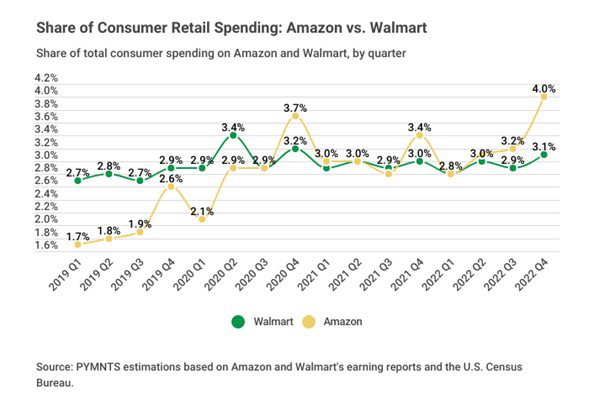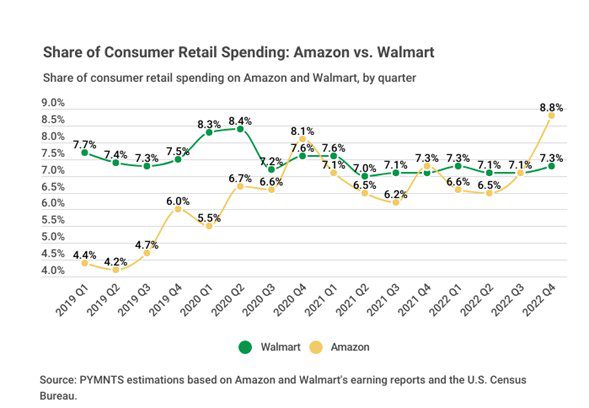
Groceries, and how and where consumers buy them, is almost as topical as generative AI these days. Food inflation remains stubbornly high, and nearly all U.S. households have adjusted the number and types of items that now end up in their grocery baskets. The latest PYMNTS research now finds that 62% of consumers say the high cost of food has caused them to reduce spending in other discretionary categories, including 60% of those earning more than $100,000 a year and 63% of the middle-class consumers earning between $50,000 and $100,000 annually.
That’s why groceries are a hot topic at the two of the largest retailers on the planet: Amazon and Walmart. Grocery was mentioned 17 times during Amazon’s Q4 2022 earnings call, 11 times during Walmart’s.
But Walmart’s general merchandise strategy was discussed almost as frequently; CEO Doug McMillon and CFO John David Rainey referenced Walmart’s general merchandise initiatives 10 times on their Q4 call. These mentions were all in the context of the need for a more invigorated retail merchandising strategy to offset “continued softness” in dry grocery and consumables.

For good reason.
With groceries now accounting for 56.9% of overall sales — up slightly from 55.9% in 2019 — Walmart is starting to look like a giant grocery store that also sells retail products instead of a mass merchant that also sells groceries.
Especially since Amazon and others have steadily taken away share in the retail categories that were once strategic drivers of sales and margin for Walmart.
According to their own and Census-reported data, we find that Walmart’s grocery share has remained relatively flat since Q1 of 2019. The world’s largest physical retailer may be seeing slightly higher grocery sales because of food inflation, but it is also making fewer sales overall in nearly every other retail product category.

Based on how the data is trending, Amazon will soon eclipse Walmart in health and beauty, a category that Walmart’s CFO called out on the Q4 call as both high-margin and a high priority.
Health and beauty accounts for nearly 11% of Walmart’s annual sales, its second-largest retail sales contributor.
Amazon has almost doubled its share of health and beauty sales since 2019, from 2.5% in 2019 to 5.1% in 2022. Walmart, on the other hand, has remained flat at around 6%.
Apparel, at 8%, is one category in which Amazon’s share is now twice that of Walmart, a sales gap that has grown from 0.8% in 2019 to 6.4%. That’s despite Walmart’s efforts to beef up its apparel business with the purchases of Bonobos, ModCloth and 2020 partnership with ThredUp.
And why?
Because Walmart has a checkout conversion problem.
No, not the same checkout conversion problem that plagues almost every online seller in the world that struggles to convert more than the mid-to upper-single digits of shoppers who visit their storefronts.
Walmart doesn’t seem to be able to convert enough of the 100 or 120 million U.S. people who walk into a Walmart store each week into shoppers who walk out with much more than food in their baskets.
It’s a battle royale — and a battlefield — that Walmart has to win, despite its efforts to drive more online volume and establish a more robust network of third-party sellers. Walmart’s 2016 $3.3 billion purchase of Jet.com was shuttered four years later after failing to drive appreciable online sales for Walmart. The company has failed to make any meaningful online traction before or since.
That makes the 100 million or so pairs of feet inside of Walmart stores each week the low-hanging fruit, the qualified buyers, the burgeoning retail sales opportunity they must convert to more general retail buyers.
Especially when Walmart’s main rival is the online player that has made online checkout conversion an art form — and has spent the last 28 years reshaping the standard for any acceptable online experience, retail or otherwise.
The Amazon Prime and Walmart+ Member Overlap
It will be a challenge, especially since 87% of Walmart+ members — the cohort of loyal customers Walmart wants to grow — also belong to Amazon Prime. PYMNTS data finds the percentage of consumers who only have a Walmart+ subscription to be in the low single digits.
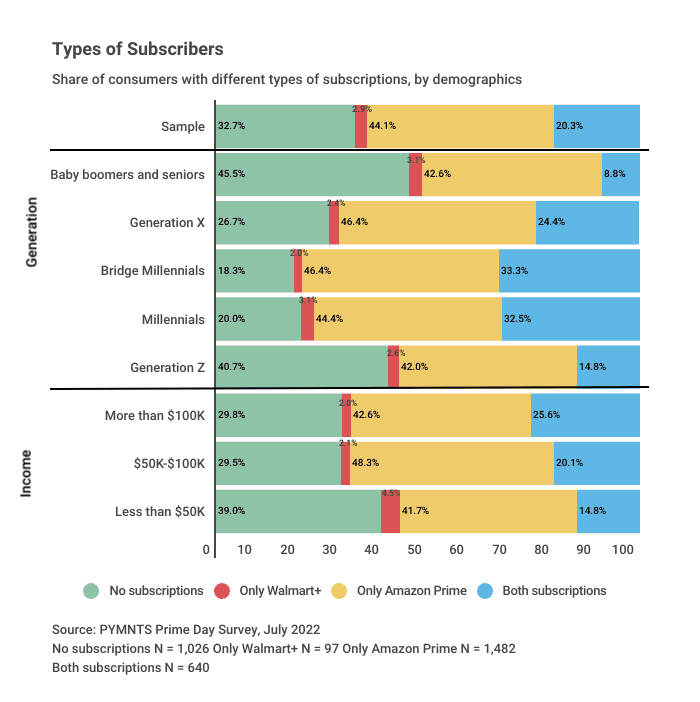
More than 70% of adult consumers living in the U.S. are Amazon Prime subscribers, some 186 million consumers. They tend to be bridge millennials (82%) and high-income earners (82%). Free shipping is not merely a membership perk — it makes it easy and possible for consumers to order any retail or grocery product, on demand, multiple times a week, or even a day, without a second thought.
Amazon’s efforts to reduce Prime fees for lower-income consumers and to accept EBT payments online also expanded its reach to the millions for whom an Amazon Prime membership fee would be out of reach — and created a new outlet for making grocery and other qualifying purchases.
Roughly 20% of U.S. adults, some 59 million adult consumers, have a Walmart+ membership. As Walmart’s CEO referenced on their Q4 earnings call, Walmart has made great strides in capturing more share of the high earners making $100,000 or more, as well as the important millennials and bridge millennials.
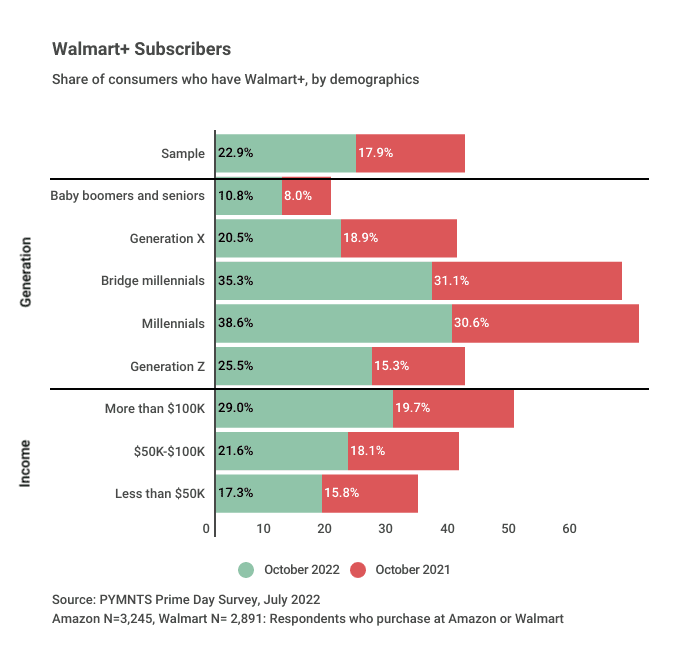
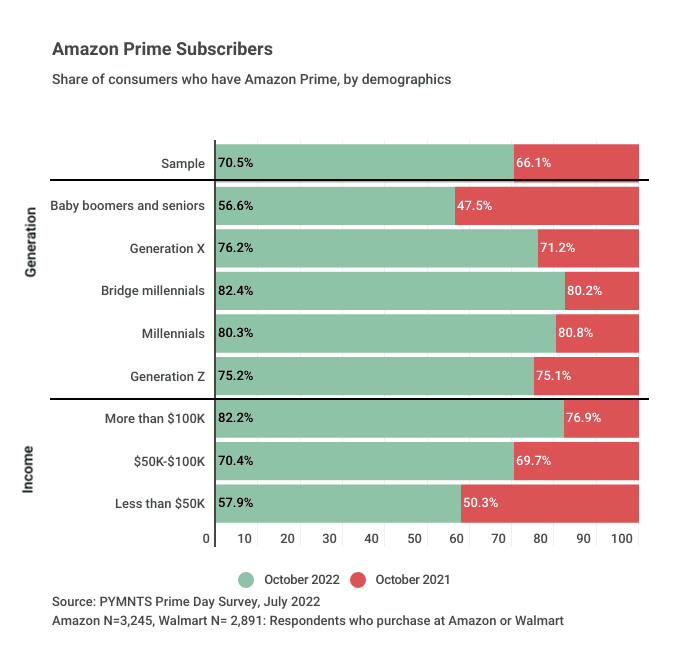
Those Walmart+ members may be pulling into the Walmart parking lot to buy or pick up groceries, but more of them appear to hop back on their laptops and smartphones to buy lots of other retail products at Amazon or other online and physical alternatives.
Amazon Shoppers Come For the Free Shipping, Stay for the Deals
Inflation-fatigued shoppers now say they’re chasing deals more than they ever did, with nearly one in four U.S. consumers now characterizing themselves as deal chasers. One hundred million more U.S. consumers now chase grocery than retail deals.
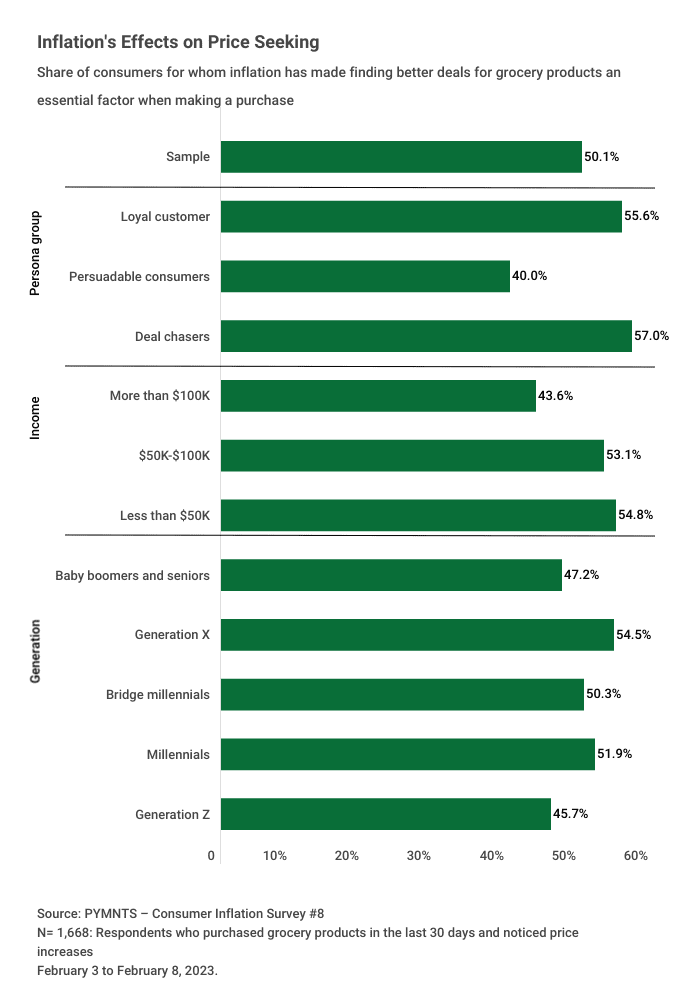
Surprisingly, this same data finds that more than three times as many grocery shoppers reported they chose Amazon for the deals offered on grocery products as those who said they chose Walmart, despite Amazon’s much smaller grocery footprint and share.
Is that because consumers factor free shipping into the mental math that shapes their perception of “a deal?”
Maybe.
One of the biggest barriers to checkout conversion is free shipping, something that increasingly drives inflation-pressured consumer preferences for which merchants get their business.
PYMNTS data shows that 83% of Amazon Prime members signed up for this membership to get free shipping, and 61% of these cited free shipping as the most important reason for their membership — a perk they use to purchase a growing assortment of retail and grocery products. Amazon’s expansion of the Buy with Prime program will offer Prime Members free shipping at more retailers that sell off the Amazon marketplace,
A study of 3,124 merchants and more than 13,000 consumers across 6 countries in December of 2022 found that free shipping is second only to payments choice as the most valued digital feature and driver of merchant preference.
It seems that a price-sensitive consumer is also now a time-sensitive consumer, as more of them return to part-time or full-time travel to work as well as shuttling kids to after-school and weekend activities. It’s likely that ordering online and free shipping has now become an “essential service.”
That’s not to say that consumers don’t value delivery immediacy — they do. In the U.S., the pickup economy is growing, with more than 41% of consumers saying that they picked up a grocery or retail purchase in 2022, an increase of 34% from 2021.
It’s a consumer itch that physical retailers — all of them — are investing in heavily to be able to scratch, to both lower their costs and outsource delivery to a willing consumer. Walmart reports a 20% increase in delivery and curbside pickup capacity in 2022, with plans to increase it by 35% in 2023. Walmart can leverage its network of more than 5,000 retail locations, all within a 15-minute drive of 90% of U.S. consumers, and data on how many widgets are sold by what store each day or each month to expand both capabilities.
Amazon is leveraging its logistics network, which CEO Andy Jassy said now rivals UPS in size and scale, with its 28 years of online shopping history at the individual shopper level, to optimize its same-day delivery capabilities for its Prime Members. Amazon says 1.5 million Prime members every month are trying Same Day Delivery for the first time, a free service for Prime Members, subject to purchase minimums.
The service is being piloted in major cities, with fulfilment centers stocked with the 100,000 SKUs that are most frequently ordered.
The interesting shopper cohort to watch as Amazon’s Same Day Delivery scales won’t be the Amazon Prime shopper whose behavior is largely predictable — they’ll likely adopt and use, and why wouldn’t they?
But the Walmart+ shopper who is also a Prime Member. This shopper may order Same Day Delivery for the things they’d ordinarily order online for pickup from Walmart or another provider — school supplies, birthday gifts, last minute travel essentials, garden supplies — and leave with groceries to meet minimum spending thresholds.
Walmart is America’s largest grocery store — a distinction that Walmart has had for the last 22 years. It was 2001 when Walmart officially became the country’s largest food retailer.
But consumers don’t think about groceries in the same way they did when grocery shopping was always done in the physical store and shoppers filled their grocery baskets with everything from lettuce and lentils to laundry detergent and loaves of bread.
The unbundling of the grocery shopping experience is easier now than ever as consumers order center-aisle products online, including 7.2% of U.S. consumers who do that using Amazon Subscribe & Save. Consumers can shop multiple grocery stores using Instacart that were once too inconvenient to visit to snag deals, subscribe to the essentials they want from specialty providers and spend their time visiting grocery stores or specialty food markets for the fresh meats, produce and bakery items they want to see, smell and touch before buying them.
More than 40% of grocery items are now purchased online, according to PYMNTS’ latest data, even though 60% of consumers still walk into the grocery store on a weekly basis.
It’s why Walmart recognizes that capturing more retail sales over the next 22 years is significantly more important than remaining the country’s largest grocery store.
There are lots of physical and online wagons circling the food retail space. New formats will emerge, including what Amazon has hinted about its plans to reflect the consumer’s desire to buy different “grocery” products from different purveyors.
Dry goods will increasingly become commodities, bought online and delivered same day, next day or at an agreed upon replenishment schedule. Going to the grocery store will likely become a different experience over time, where shopping a store with fresh fruits, veggies, meats, cheeses and baked goods will be an experience to see, sample and then buy those perishables without spending an hour with the kids in tow, wheeling a cart around a vast store with 35,000 SKUs and a checkout system that increasingly makes the consumer do it themselves.
It’s why the battle for Amazon and Walmart’s retail share over the next two, never mind the next 22 years, won’t only be fought in the grocery aisles, but in just about every other product category. Retail, pharmacy, and now healthcare with Amazon’s One Medical purchase.
As of Q4 2022, Amazon now accounts for 8.8% of consumer retail spend, to Walmart’s 7.3% and 4% of overall consumer spend to Walmart’s 3.1%. This performance shows the vulnerabilities in Walmart’s physical and grocery store model and highlights its failure over the last two decades to make any meaningful impact online — and to convert higher income, younger shoppers to loyal customers who aren’t only chasing cheaper food prices.
It will be interesting to see what Q4 2023 may bring.
